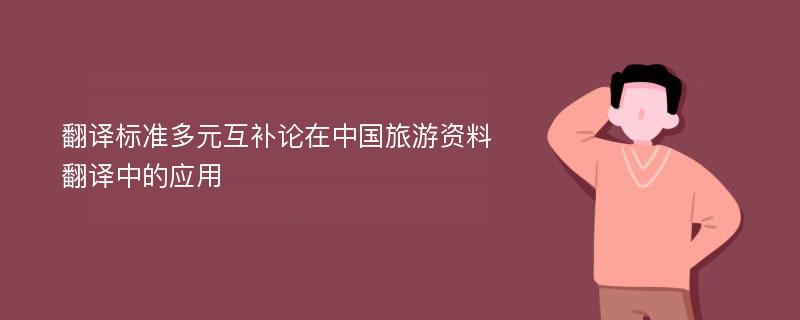
论文摘要
本论文试图用辜正坤先生提出的翻译标准多元互补理论来对旅游文本的翻译进行分析和研究。论文也试图寻找一个更好的策略来解决旅游文本翻译中所遇到的困难。所以本论文提出了一些有用的方法并运用到旅游文本的翻译中。为了达到此目的,本论文分为五部分来探讨此问题。概论部分对全文的总体情况予以概括说明。第一章回顾了国内外对旅游文本翻译研究的现状,并提出翻译标准多元互补理论,分析了该理论的特点。第二章提出了语言、文化和翻译三者的关系,说明文化不同在旅游旅游翻译中的影响,指出中外巨大的文化差异给旅游资料的翻译带来了困难。并指出文化差异是旅游翻译中的巨大障碍。第三章分析了中文的旅游文本特色,并进一步阐述其给旅游翻译造成的困难。第四章在翻译标准多元互补理论的指导下,从词汇,文化,语言特点,以及文学对旅游文本进行了分析。运用本章所提到的方法,将理论和实践密切结合起来,对北京故宫的旅游宣传的汉语文本翻译成英语,进一步证实多元系统论的实用性。最后一部分试图得出结论,辜正坤先生提出的翻译标准多元互补理论基本上适用于旅游文本的翻译。
论文目录
AcknowledgementsAbstract摘要IntroductionChapter 1 Relevant Studies on Tourist Translation and the Theory Applied in the Paper1.1 Relevant Studies on the Tourism Material Translation within China1.1.1 Research from the Cultural Perspective1.1.2 Research from Perspective of Textual Functions1.1.3 Research from Perspective of Pragmatic Approach1.2 Theory Applied in the Thesis1.2.1 What's "Plural Complementarism of Translation Standard" (PCTS)?1.2.2 Comment on the theoryChapter 2 The Relationship Between Language, Culture and Translations2.1 Definition of Culture2.1.1 Main Aspects of Culture2.2.1.1 Material Aspect of Culture2.2.1.2 Intellectual Aspect of Culture2.2.1.3 Communicative Aspect of Culture2.2.1.4 Institutional Aspect of Culture2.2.1.5 Conceptual Aspect of Culture2.2 Translation2.2.1 Definition of Translation2.2.2 Translation and Culture2.3 Translation Barriers Caused by Cultural Differences2.3.1 Zero of Equivalent Word2.3.2 Conflicts of Word Meaning2.3.3 Semantic Association2.3.4 Pragmatic Implication2.4 Cultural Differences Reflected in Tourism2.4.1 Culture Discrepancies in Psychology2.4.2 Discrepancies in Aesthetics2.4.3 Discrepancies in Religious Beliefs and Thinking Patterns2.4.4 Discrepancies in Social Customers and Moral StandardsChapter 3 Features Analysis of Chinese Tourist Texts3.1 Flowery or Ornate Description3.2 Four-Character Collocations in Chinese3.3 Wide Use of Rhetorical Devices3.4 Quotation of Allusions3.5 Quotations of Poetic Lines or LegendsChapter 4 Tourist Materials Translation under the Guidance of Plural Complementarism of Translation Standard4.1 From the angle of Lexical Level4.1.1 The strategies in Translating Names of Scenic Spots4.1.1.1 Transliteration and Proper Use of Free Translation plus Interpretation4.1.1.2 Transliteration of Proper Name plus Generic Name4.1.1.3 Transliteration plus Explanation4.1.2 The strategies in Chinese Dishes4.1.2.1 Literal Translation4.1.2.2 Free Translation4.1.2.3 Transliteration plus Explanation4.1.2.4 Literal Translation +Explanation/Free Translation4.1.3 Metaphrasing4.2 From the angle of Cultural Information4.3 From the style of Chinese Expressions4.3.1 Amplification4.3.1.1 Amplification by Adding Some Background Information4.3.1.2 Amplification by Paraphrasing Information4.4 From the Angle of Literary Style4.4.1 Translation of Ancient Chinese Mountains and Waters Poems4.4.1.1 Rewriting4.4.1.2 The Beauty of Sound4.4.1.3 The Beauty of Form4.4.1.4 The Beauty of Ideorealm4.4.1.5 Roughly Antithesis4.4.1.6 Translation of Chinese Couplets4.4.2 The Symmetry in Syntactic Level4.4.2.1 Changing the Syntactic Structure to Achieve Equality in Target Language4.4.2.2 The Symmetry in the Level of the Lexical Meaning4.4.3 Pragmatic Level4.5 Translation of Palace MuseumConclusionBibliography
相关论文文献
标签:旅游翻译论文; 翻译标准多元互补理论论文; 文化差异论文; 翻译标准论文;

